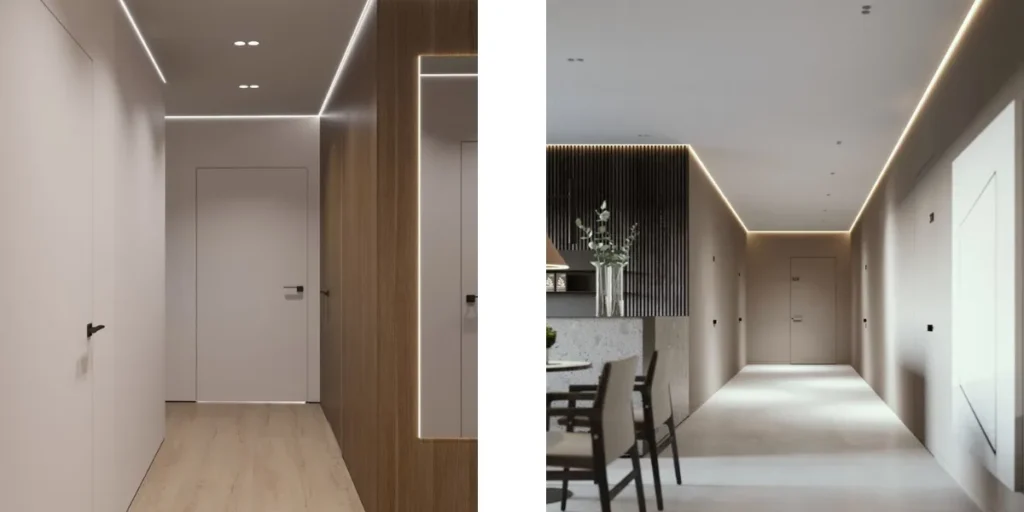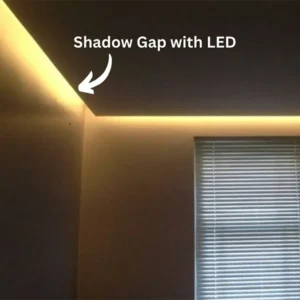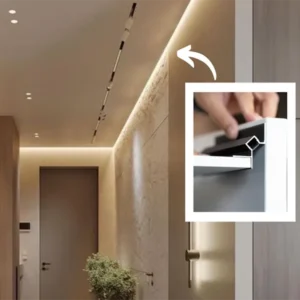Shadow gap with LED is one of the most understated yet effective interior design features that can immediately make a room look sleek and modern. This architectural feature entails a recessed area (or gap) between the ceiling and the wall, or between skirting and walls, combined with LED illumination to form a soft, luminous outline. It is a design method applied by experts to decorate residential and commercial areas equally, bestowing upon them a sophisticated and luxurious environment without overwhelming the eyes.
Why Use a Shadow Gap with LED
Contemporary interior design and architecture prioritize minimalism, clean lines, and lighting as a design element—not solely as a requirement. Shadow gap lighting manages to incorporate these elements perfectly. When you put LED lights into a shadow gap, the effect is a floating appearance—cabinets, ceilings, and walls seem to be illuminated from the back. The glow is silky and seamless, making for an opulent ambiance in living areas, bedrooms, corridors, and even workspaces.
Homeowners and designers start realizing the way this solution brings sophistication. To take it a notch higher, indoor LED profiles tend to enclose the LED strips safely in addition to dispersing the light uniformly for a silky professional touch.
The Benefits of Using Shadow Gap with LED
There are numerous benefits of having a shadow gap with LED in your design:
- Ambient Lighting
The most direct advantage is ambient lighting. This type of indirect lighting minimizes glare and provides a warm, soothing mood. It performs especially well in bedrooms and lounges where softer light is more pleasant. - Space Enhancement
LED-infused shadow gaps make spaces seem larger and more open. The floating effect provides visual depth and dimension to otherwise flat space. - Energy Efficiency
LEDs use less power than conventional lighting systems, so you have a high-quality appearance at no extra cost. - Design Versatility
Whether you’re designing a sophisticated apartment or a luxury hotel, shadow gaps with LEDs play perfectly. You can mount them on ceilings, walls, floors, or even behind cabinets.
Include a LED corner profile light to accentuate corners and edges of a room, providing an entirely immersive lighting effect that showcases architectural features.
How to Implement Shadow Gap with LED Lighting
Producing this effect is not as difficult as it can seem. Here’s a simple guide:
Step 1: Planning the Shadow Gap
Determine ahead of time where the shadow gap will be before construction or renovation work begins. Most frequently, these locations are:
Where the wall meets the ceiling
Above skirting boards
Around cabinets or shelving
Step 2: Choosing the LED Lighting
The choice of LED matters. You’ll want a LED profile light that emits soft, consistent light. The brightness and color temperature should match the room’s function. Warm white light is ideal for relaxing spaces, while cool white is better for workspaces.
Step 3: Install LED Profile Housing
Use a profile light strip as a housing for your LED strip. These strips encase the lights, ensure proper alignment, and the aluminium housing also helps dissipate heat.
Step 4: Connect and Conceal
Make sure wires and connections are all secured within the wall or ceiling cavity. The aim here is to hide the source of the light while allowing its impact to take center stage.
To accentuate small spaces or furniture edges, employ a slim LED profile for a less noticeable finish.
Ideal Rooms for Shadow Gap with LED Lighting
You can utilize this sophisticated lighting method in nearly every room:
- Living Room
Establish mood lighting that creates a calming atmosphere. Fit a shadow gap across the ceiling edge or in the back of wall-mounted entertainment units. - Bedroom
Utilize shadow gaps at the back of the bed frame or along the ceiling to make a soothing refuge. - Kitchen
Combine lights at the bottom of overhead cabinets or at the perimeter of kitchen islands using corner LED strip lighting to improve task illumination while still having a pleasing design. - Bathroom
Even in humid spaces, LED light shadow gaps can deliver spa-like tranquility. Just make sure the lights are damp-rated. - Hallways
Lighten up corridors discreetly without the use of multiple ceiling lights. It also improves night safety.
Insert a mini LED profile in smaller, enclosed areas where standard profiles wouldn’t be able to fit, giving the same high-end look.
Creative Design Ideas Using Shadow Gap with LED
Floating Ceilings: Achieve a modern dropped ceiling look with shadow gaps illuminated by LED lights on the periphery.
Staircase Accents: Use LEDs in the shadow gaps between stair risers to create a floating stair effect.
Art Wall Highlighting: Use shadow gap lighting to enhance artwork or textured feature walls.
Cabinet Highlights: Create depth to kitchen or wardrobe cabinets with built-in LED lighting.
Maintenance and Safety Tips
Select Quality Materials: Materials are hard to find in the market, so by spending on good quality LED strips or profiles, one will never need to worry about flickering or heat damage.
Install a professional: If it is ceiling installation especially, an expert installer will ensure safe installation of all things and proper alignment.
Install a Dimmable Switch: This is for adjusting brightness levels, depending on moods or time of day.
Keep it Clean: Dust, dirt, etc., can settle down in profiles with time. Clean gently to maintain brightness.
A Touch of Architectural Elegance
Giving few reasons for designers to apply shadow gaps with LED lighting is the architectural beauty they provide. These light accents add depth, drama, and class to bare surfaces, bringing glamor into a room without being too much. The mild glow of hidden LEDs is a curtain of intrigue that allows the room to be highly designed in its right design strategy that transforms bland interiors into wow experiences.
Conclusion
Adding a LED to your home or office isn’t only a fad—it’s an eternal, utilitarian design aspect that enhances aesthetics and ambiance. From constructing a new house to renovating an existing one, the method of this kind of lighting is a cost-effective means of getting a luxurious look. With appropriate light design and materials, even bare rooms can resemble high-end interiors.
Frequently Asked Questions:
Can I install a shadow gap with LED in an already constructed room?
Yes, it’s possible but might involve drywall alteration or bespoke moldings to form the recessed space. A professional will be able to advise on the most suitable method.
Which color LED is ideal for shadow gap lighting?
It depends upon the room’s function. Warm white (2700K–3000K) is perfect for bedrooms and living rooms, and cool white (4000K–6000K) is ideal for kitchens and offices.
Are shadow gaps with LEDs expensive to maintain?
Not at all. LED lights are long-lived and use little power. The infrequent cleaning and occasional replacements make them extremely cost-effective.




